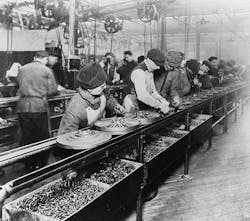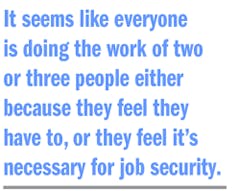Doing more with less is a common phrase in industry today. It seems like everyone is doing the work of two or three people either because they feel they have to, or they feel it’s necessary for job security. However, overworked employees may not be as focused. They’re also more prone to making costly mistakes and miss the social interactions and connections that lead to creative or innovative solutions. Is working harder and longer the answer to our economic problems, or a slippery slope that is causing more harm than good?
To keep jobs in America, experts have said we need to focus on production versus cost. However, I am reminded of Henry Ford. In the early 1900s, things didn’t look too great for the average American. There were big names such as Vanderbilt, Rockefeller, Carnegie, and the house of Morgan pushing workers hard and paying them little. Injuries mounted as tired men worked long hours. Dr. W. David Lewis from Auburn University’s Department of History said in an interview with the History Channel, “The standard work week in the steel industry was 84 hours per week. For 84 hours of brutal labor in the steel mill, [workers were often paid] less than $10 a week.”
This was a time of low income taxes and little government oversight. The key to success was to get as much out of the workers as possible while reducing wages and eliminating competition to form a monopoly. The Association of Licensed Automobile Manufacturers (ALAM) was considered one of these monopolies. They patented the gasoline-powered vehicle that gave them dominion over the new industry.
Regardless, this case opened the doors to car manufacturers and launched Ford’s model of increasing production and lowering cost. In contrast to the business model at the time, Ford paid his employees well and offered a shorter workday to grow productivity, talent, and local economies. If the masses can’t afford your product, mass producing it doesn’t sound like a great idea.
To bolster productivity and innovation today, it may help if we shift employment to more of a Ford-based model. We also need to invest more heavily in employee training and support. Automation and IIoT are replacing lower-skill positions, but generating more work and a need for skilled employees. If companies don’t support continued education and training, it might be increasingly difficult to find qualified employees.
Don’t forget: This U.S. economy has largely been built with the innovation that came out of garages. If employees are too poor to have a garage, buy tools, or have spare time to tinker, what’s going to happen to our innovation and economy? Ford—who built his first car in a barn—saw that taking care of employees, and not cutting wages, would grow a company, and create a stronger economy that worked for everyone. By raising employee skills, companies also are contributing more talent to the U.S. work force.



